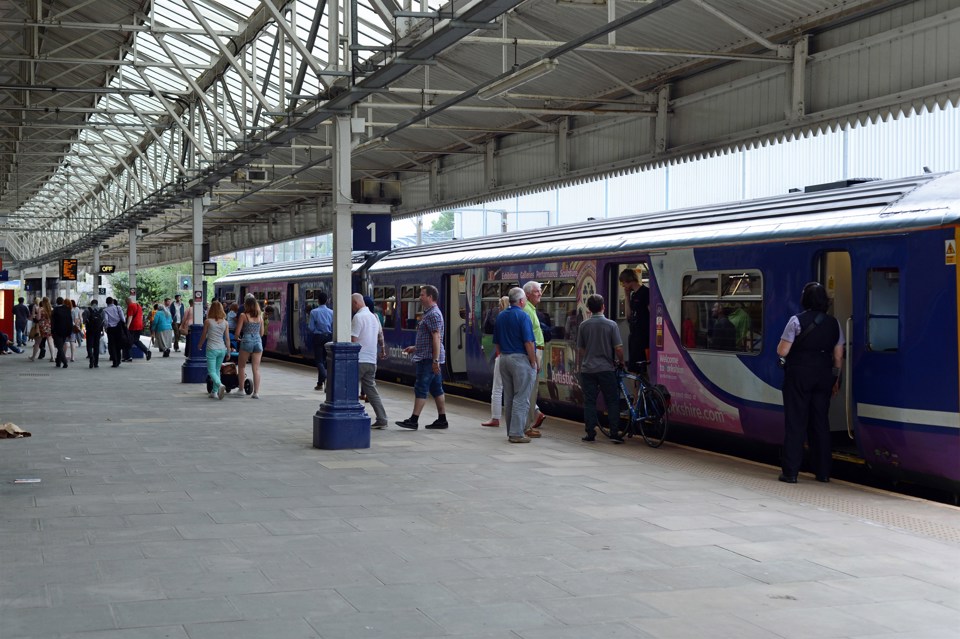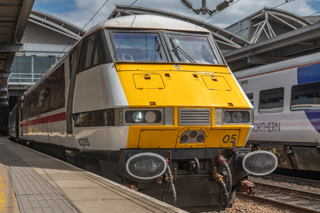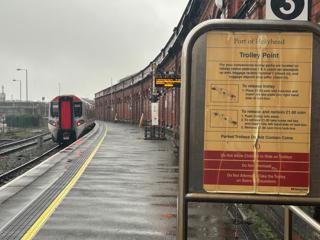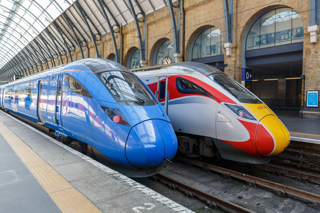RAIL photography: PAUL BIGLAND
Day 6
The penultimate day of my trip begins at the magnificent Grade 1 listed station at Huddersfield. There are few stations of its size that can boast two excellent pubs, a great station cafe, and host an artisan baker’s stall every Wednesday. It’s a reflection of the way that stations have reinvented themselves to become part of the community again, and not just a place to catch a train.
I have arrived to catch the 1011 to Manchester Piccadilly, but it is running several minutes late - a frequent occurrence nowadays as the new TransPennine Express timetable is testing the resilience of the railway. The geographical spread of the franchise, allied to pinch points at Leeds and Manchester Piccadilly, makes timekeeping difficult.
Six minutes late a packed 185109 arrives, leading to a scrum of passengers embarking and disembarking. I manage to find standing space in a vestibule, and ponder on why the UK still insists on running a Sunday service, even though the evidence suggests that passenger numbers are buoyant seven days a week on many lines.
It is a shame that I have to stand, as the trans-Pennine routes are beautiful lines to travel over. They encompass glorious scenery, plus a fascinating architectural and historical landscape. They are the industrial North at its best.
Sadly, stuck in a vestibule you don’t really get to appreciate the views! But in a few years’ time the electrified railway will have extended its wiry tentacles across the route, bringing with it longer and faster trains, so hopefully fewer of us will be stuck in doorways.
All too quickly (for me at least) we have penetrated the Manchester suburbs, and pass Ashburys, where Network Rail has built one of its massive Rail Operating Centres (ROCs). Most passengers won’t appreciate their significance, but 12 of these centres will eventually replace 800 old signalboxes in a huge investment that promises to improve the performance of the network (even if it deprives us of some lovely architectural gems).
Shortly after, the modern Siemens depot that maintains the Class 185 fleet comes into view. Neither train nor depot existed a decade ago. Back then, I used tired Class 158s with dodgy air-conditioning. How times have changed!
Entering Manchester Piccadilly, we crawl past a group of Network Rail workers, busy maintaining the complicated trackwork on the approach to a bustling station that contains a diverse range of trains. From the humble BR-built Pacer to the mighty Alstom Pendolino, few stations boast such a mix of fleets or range of ages.
My next steed is an ex-BR Class 150 on the 1133 to Southport (operated by Northern). I am disappointed that the operator has only provided a two-car train to the seaside on a summer Sunday, and it is packed. A blessing in disguise is that the front compartment has had all its seats stripped out, allowing more room for people to stand.
Our route is along along the congested double-track section through Oxford Road, but relief is on the way, as the Northern Hub project will tackle this bottleneck.
I just hope Northern will then be able to run better trains through it. After picking up more passengers at Salford Crescent and Bolton, we are doing a very passable impression of a sardine can, one flavoured by a mixture of stale tobacco, cheap perfume and BO.
At Wigan Wallgate we swap one heaving mass of humanity for another. The seatless compartment fills up with prams and bikes, re-creating the luggage area of the old first-generation DMUs. Perhaps that was Northern’s cunning ‘missing seats’ plan after all.
Passing the stabling sidings, insult is added to injury as nearly a dozen DMUs sit idle. Try explaining that one to your average passenger, forced to stand! I am not sad to see this journey end, and am grateful when the outskirts of Southport hove into view and we can bid goodbye to what has not been Northern’s finest hour.
I am in Southport to sample the town’s other operator, Merseyrail. Both Network Rail and Merseyrail have invested in the past decade, and the station boasts a refurbished roof, ticket gates and redeveloped entrance, where the old ticket office has been replaced with an Mtogo combined retail outlet. It’s a great improvement.
The trains have also been refurbished, and the Class 507 that takes me to Liverpool is a very different beast to when they first arrived on the line in 1978.
In a decade, Merseyrail has transformed Liverpool’s network of DC lines. There’s not a station left untouched - all have received a makeover of varying degree, from massive refurbishments/rebuilding at Bootle Oriel Road to restoration of Art Deco buildings at Hoylake.
And that’s not all. Merseyrail has tackled anti-social behaviour as well, banning alcohol on trains and famously prosecuting people for putting their feet on train seats.
My trip ends at Liverpool Central, another huge refurbishment project costing £20 million with a greatly improved upper concourse. My eye is caught by the table football machines, in an area dedicated to the football World Cup.
Walking across to Lime Street, I find yet another refurbished station. It used to be hidden behind an awful 1960s office development, but that has been swept away, and the station now proudly takes its place in the pantheon of impressive public buildings that Liverpool has in abundance.
There’s a nice touch on the concourse, too, where statues of two famous Scousers (MP Bessie Braddock and comedian Ken Dodd) pay tribute to the city’s cultural and political influence. And passenger facilities haven’t been neglected either. Virgin Trains has invested in new passenger lounges that have taken over the old taxi rank between Platforms 7-8.
The only retrograde step that I can find is the former Head of Steam pub. Once it was a glorious place full of railway memorabilia and boasting an impressive range of real ales - you could enjoy a pint and spend ages browsing all the knick-knacks. Today all that’s gone. The memorabilia has vanished, along with the real ale… and all the customers.
Wandering back across the concourse to Platform 6, I board a TPE diesel Desiro to head back to Yorkshire. This is a busy train, and I end up sharing a table with a family who are fully provisioned for the trip. Along with the rest of the group on the table opposite, they have laid out a picnic of tempting snacks and drinks purchased from the station’s Marks & Spencer’s.
The matriarch of the family soon strikes up a conversation with me (my professional camera is always an ice-breaker and talking point), and by the time we pass Edge Hill I have been offered a glass of wine.
Such convivial company makes the trip to Manchester a pleasure. When they find out why I am travelling and what I am doing, they are both fascinated and incredulous that someone would attempt such a trip. In return, I find out they are a Newcastle family who had travelled to Liverpool to celebrate the son’s 40th birthday. They are lovely company, and I am sad to leave them at Stalybridge, but I have other places to explore.
After waving them goodbye I turn my attention to the expanded station, which has sprouted two extra platforms in the past couple of years. Northern Hub funding has made the place an important boundary for services around Manchester and the North West, and the two new platforms allow Northern to run more services through Manchester Victoria rather than terminating them, freeing up capacity at the shrunken station.
Of course, there’s another reason to visit - the sublime station bar. Landlady Sylvia recently retired, but there is still a warm welcome and a great range of real ales and bottled beers. It’s Sunday, so the ‘Rail Ale’ crowds are absent, and I have space to enjoy a quick pint and a chat with some of the regulars whom I know, before a Northern service arrives to carry me on to Huddersfield.
The Manchester-Huddersfield train is an important cross-Pennine service that really does need to be expanded to half-hourly, but paths are scarce. Sadly, the service will be disrupted from 2016 when a skip pattern will be introduced, disrupting the extremely popular ‘Rail Ale Trail’.
Some may see this as a blessing in disguise, however, as it has become a victim of its own success. After James May and Oz Clarke showcased it on TV, the Rail Ale Trail has been inundated by stag and hen parties who have no interest in real ale, and who have turned it into a bit of a nightmare for both villagers and train crew. In response, many pubs have banned people in fancy dress and refuse to sell lager at weekends.
On Saturdays, the platforms at Marsden can resemble a Bacchanalian revel with drunks spread out onto the tracks, seriously risking life and limb on what is a high-speed blind bend for the poor train drivers (who must dread it). Luckily, my trip is trouble-free, with only a handful of merry middle-aged men joining us for the trip.
Back at Huddersfield, I opt to explore one of the station’s two pubs, and pop into the lesser known of the two - the Kings Head. It is Sunday, so a live band is playing, and the bar echoes to the sounds of local band ‘JB Goode’ belting out rock and roll classics to an appreciative audience. I wonder how many other Grade 1 listed stations regularly feature live music?
Moving on again, I catch Northern’s colourful Tour de France-livered 158849 to Leeds. The fabric of the station has changed little in a decade, but now it’s much, much busier. Footfall has increased from 14.7 million in 2004 to 26.2 million in 2013. To cope with the flow of people, and to accommodate local redevelopment, a new Southern entrance is under construction.
After a brief exploration and a chance to take some pictures, I leave the hustle and bustle of Leeds on my final train of the day, one of Northern’s much-maligned Pacers (142087).
At this point, I have a confession to make. I really don’t mind Pacers. They have served the railways well. OK, they’re not much fun on jointed track, hence the sobriquet ‘Nodding Donkeys’, but I can’t help thinking they will be around in some form or another for a good few years yet.
My ‘Donkey’ nods its way to Bradford Interchange, where we reverse before it deposits me back in Halifax and the end of my day’s travels. Just one day left to go...
Day 7
My final day (as Day 1 did) begins aboard a Grand Central service, but this one only takes me a few miles down the road to visit what I had once voted Britain’s worst railway station - Wakefield Kirkgate.
A decade ago, it would have made a great location for a war movie. The rotting and abandoned main building and surrounding dereliction was a depressing sight, while the subway connecting the skeletal remains of the island platform was notoriously unsafe.
And now? Dereliction has been replaced by industry, with a £4.6m redevelopment scheme under way. The station is a hive of activity, as builders swarm over the scaffolding enveloping the main building.
The skeletal remains of the island platform’s roof has been put out of its misery, and dispatched to a scrapyard. In its place there is a resurfaced platform, a new waiting shelter, new lighting, and even steel sculptures. The subway’s roof has been replaced, and new glazed panels let in natural light to the ramp.
It’s wonderful to see new life being breathed into this Grade 2 listed station. When it’s complete, the building is planned to house a cafe, ticketing, retail and office space, and a community meeting place, as well as ‘incubation’ units for small businesses.
Wakefield has done well out of the rail regeneration stakes, as a short walk to the town’s other station (Westgate) testifies. In 2013, an £8.6m project replaced the cramped BR station with a new building, footbridge and lifts, and redeveloped the area outside to include a massive 900-space car park. It’s spacious and a pleasure to use, compared with the original.
From Wakefield Westgate I catch a local Northern EMU service to my next destination - Doncaster. The town has long been associated with the railways, and still has a major role to play. It’s a busy, congested hub, and when things go awry you’ll see passenger and freight trains queuing to get through the bottleneck it creates.
But today is a good day, and my East Coast service is on time and fairly empty. I have no problem getting a seat in the Mk 4 buffet car, although much to my chagrin, the shop is closed for the entire journey to Retford. Still, the coach is clean and comfortable, and the power sockets allow me to give my phone a welcome battery boost.
I plan to change at Retford to allow me to sample Hull Trains, and the break gives me opportunity to explore the town’s attractive station.
Although the surrounding yards have shrunk in size, and the famous flat crossing is long gone, the original station building is intact. As well as the usual ticket office and cafe, it’s the headquarters of the Bassetlaw (North Notts) Railway Society, which displays some fascinating old photos in the clubroom windows.
In another room is a plaque commemorating the sterling wartime work of the local Women’s Voluntary Service (WVS), who used it to serve a staggering 2,284,000 meals to servicemen during the Second World War!
Pondering on their Herculean efforts, I cross over to Platform 3 to catch Hull Trains’ 1109 service back to Doncaster, before then heading back south to Grantham on HT’s 1326 service.
Hull Trains must be unique, in that in the decade since 2004 it has replaced its entire train fleet three times!
Back then it had just taken delivery of its brand new three-car Class 170s, replacing the sets hired in from Anglia. By the following year, traffic growth had allowed the open access operator to replace these with four-car Class 222s. In 2008, those units were controversially transferred to Midland Mainline, and replaced with cast-off ex-First Great Western Class 180s. In the years since, the ‘180s’ have been refreshed, and I have to admit that HT has done a good job with them.
Neither service is particularly busy, so I have no problem getting a seat. FGW-style mocquette has been applied to the original seat frames, and they have been fitted with power points and received an internal repaint, leaving them bright and attractive. The staff are equally smart, as well as being friendly and efficient.
But not everything goes swimmingly. I make both trips on the same set and coach (B in 180110), which suffers from a couple of frustrating niggles. The PA is poor quality, leaving many of the announcements inaudible, and the free WiFi is very frustrating - in one direction it packs up as soon as I log on, while on the return it keeps dropping out all the time, rendering it unusable. It’s a shame really, as all the open access operators get good passenger satisfaction scores.
Swapping TOCs at Grantham, I transfer to East Coast’s 1418 to King’s Cross, for my final leg of the tour and a return to my starting point - London.
The Mk 4 set I catch is busy, but I secure a seat and settle in to enjoy the trip. And the crew (I’m guessing they are from Newcastle) are a delight, full of enthusiasm for their job. There is a lovely personal touch when one of them comes on the PA to announce that it is the First Class Trolley Host’s birthday, and asks all the passengers to wish them a happy one!
The hour-long journey flies by. We whiz through Peterborough, and only stop once - at Stevenage, where I am amused to see a very unrailway-like small plastic shed on the opposite platform. It immediately puts me in mind of Grandpa Potts’ shed in Chitty Chitty Bang Bang. Perhaps station staff are trying to find an attraction to rival Harry Potter’s trolley at King’s Cross?
Into London, and the next things that catch my eye are the expanding rail depots at Bounds Green and Hornsey.
After decades of dereliction, the former Up ‘Coronation’ sidings at Hornsey are being converted into a new depot for the massive new Siemens train fleet that will grace the Thameslink network.
Expansion is also taking place at the former First Capital Connect depot at Hornsey. Add in the new platforms that have been built at Alexandra Palace and Finsbury Park, and it’s clear this part of north London and the East Coast Main Line is receiving substantial new investment.
A few minutes later we pull into King’s Cross and my journey comes to an end. Re-running it in my head, it’s hard to take in the sheer number of improvements I have seen. And unlike mine, that journey continues. If RAIL is daft enough to get me to do this again in 2016, you’ll be reading about a lot more next time...
- This feature was originally published in RAIL 759, on 15 October 2014
Read All-Line Rail Rover Part 1 and All-Line Rail Rover Part 2.
















Login to comment
Comments
No comments have been made yet.